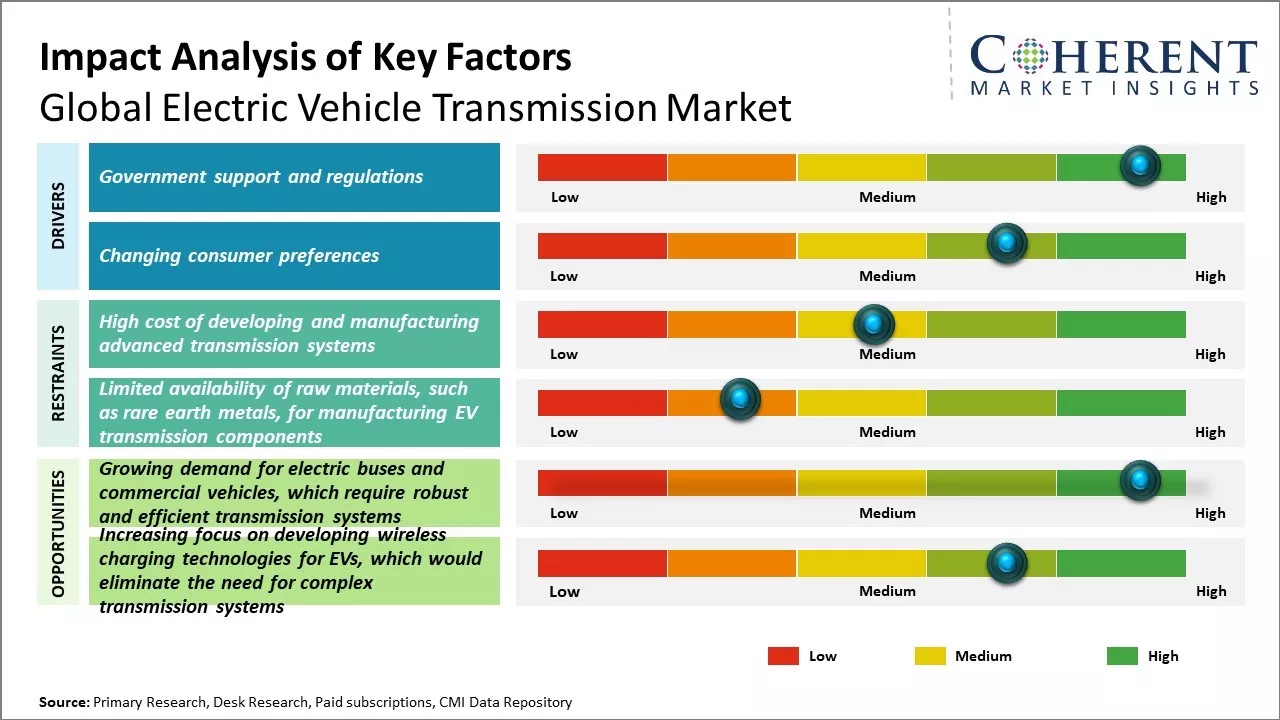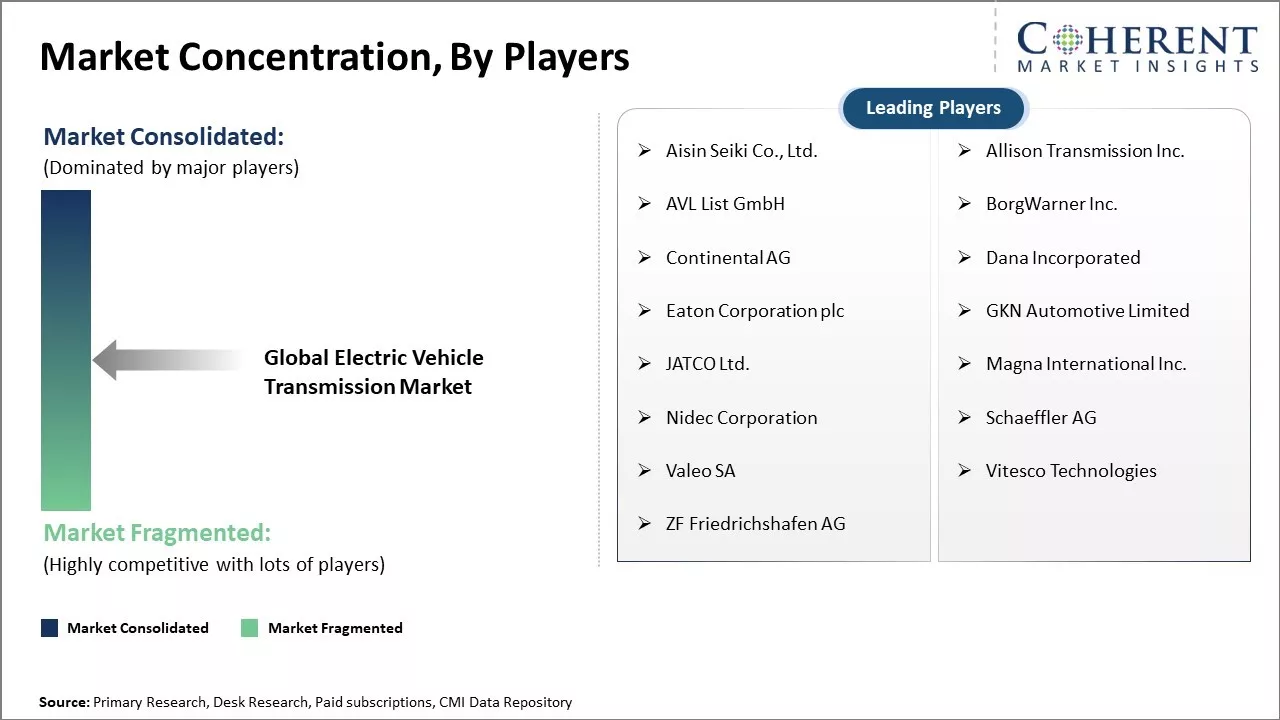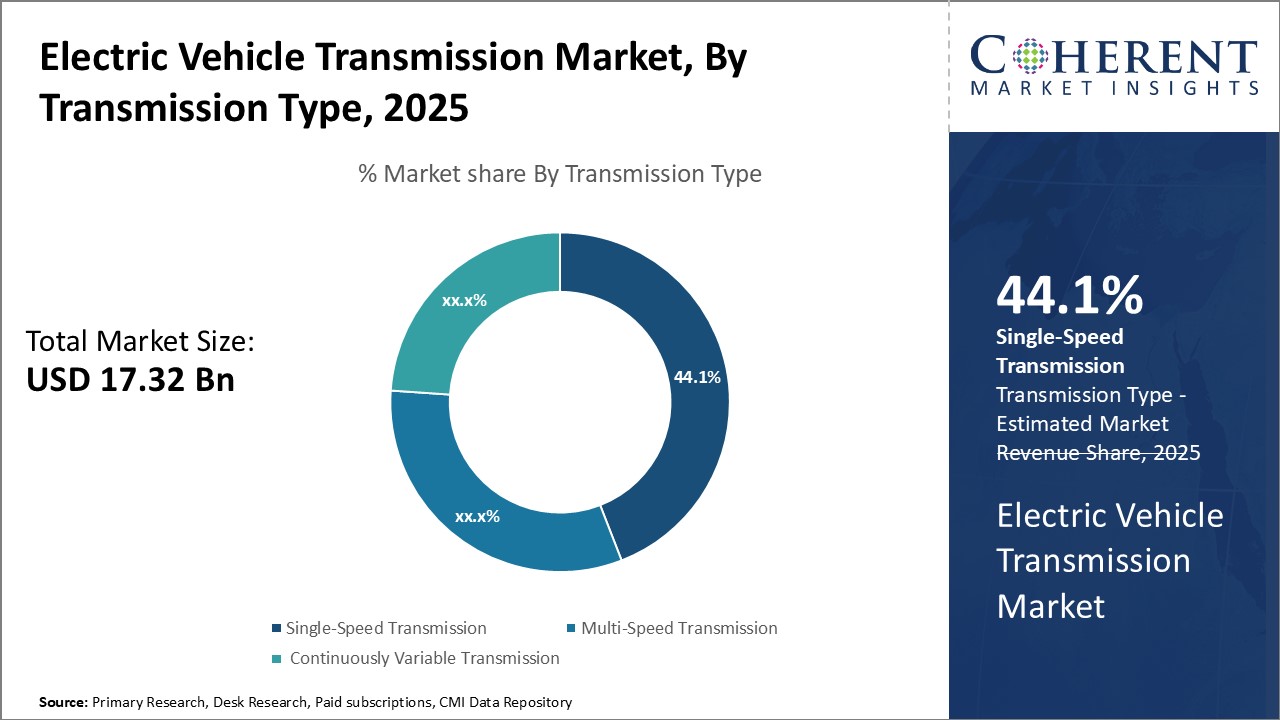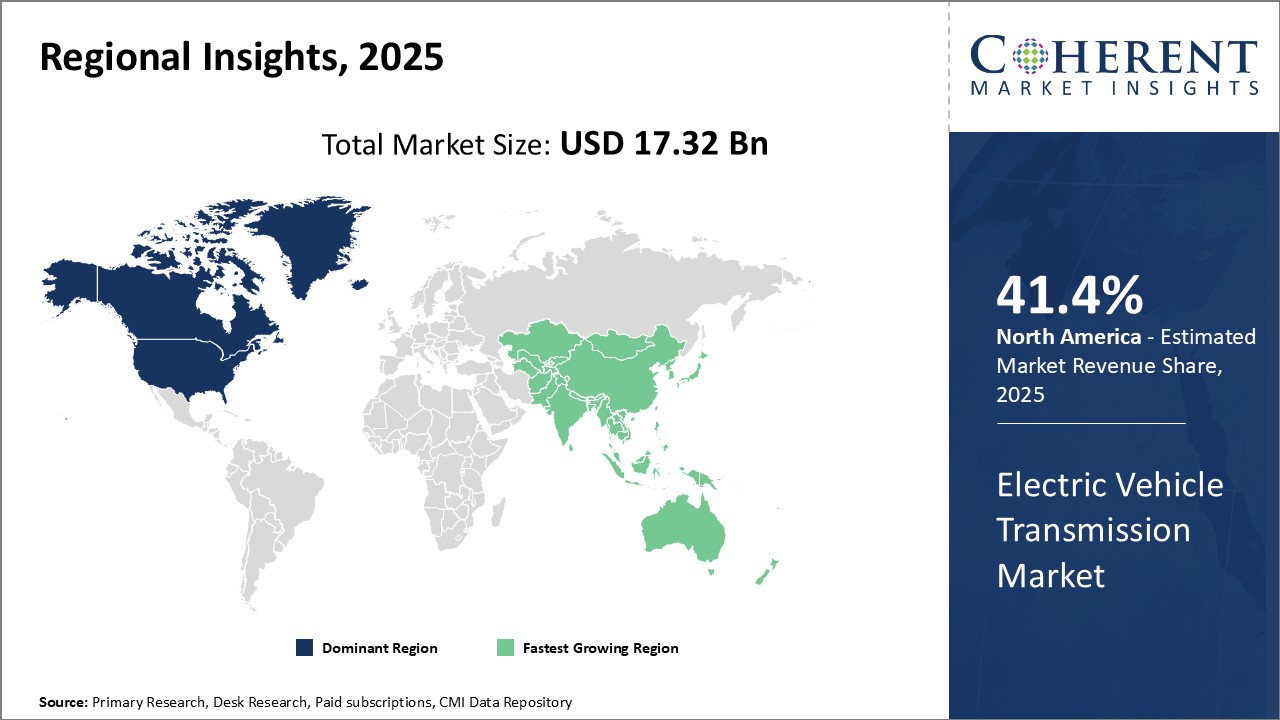Global electric vehicle transmission market is estimated to be valued at US$ 17.32 Bn in 2025 and is expected to reach US$ 42.06 Bn by 2032, exhibiting a compound annual growth rate (CAGR) of 13.5% from 2025 to 2032.

Discover market dynamics shaping the industry: Request sample copy
Stricter emission norms for electric vehicles globally can boost demand for electric vehicle transmission. Major automotive companies are shifting focus towards developing electric powertrains for commercial and passenger electric vehicles. Furthermore, declining battery prices and advancement in battery technology makes electric vehicles more viable and affordable option for consumers. Growing consumer demand for fuel efficient vehicles along with government support through subsidies and incentives on electric vehicles purchase boosts the sales of electric vehicles. However, complexity and high cost of electric vehicle transmission systems as compared to conventional transmission can hamper wider adoption of electric vehicles.
Government support and regulations
Many governments around the world have realized the need to shift towards more sustainable modes of transportation, in order to reduce carbon emissions and pollution levels. Several nations have drafted and implemented stringent regulations and policies targeted at accelerating the adoption of electric vehicles. Major economies like China, U.S., Germany, France, U.K., and others had announced bans on the sale of conventional internal combustion engine (ICE) vehicles within the next 10-15 years. This has motivated large scale investments into EV manufacturing and infrastructure development. Governments are offering purchase incentives and subsidies for EVs as well as exemptions from road tax and tolls. Setting emission caps on new cars along with fuel efficiency and emissions standards have compelled automakers to invest heavily in electrification of their product portfolio. Conversion of public transport fleets to electric is encouraged through procurement policies. Certain countries have developed extensive public charging networks and are working on building strategic locations and highways that can facilitate long distance travel in EVs.

Get actionable strategies to beat competition: Request sample copy
Changing consumer preferences
Rising environmental awareness, evolving mobility needs and attractive total cost of ownership have triggered a shift in consumer preferences. Customers now prefer more sustainable yet feature-rich transportation options. The potential to reduce fuelling costs significantly while gaining silent, vibration-free driving experiences is appealing many first-time EV buyers. Advancements in battery technology have alleviated range anxiety concerns. to Automakers are able to offer longer range vehicles that can meet daily driving needs of the average user. An array of exciting new electric vehicle models from different segments like SUVs and premium/luxury categories has increased choices for consumers. Technology features like zero emission drivetrains, smartphone integration, autonomous driving assists, and others further add to the appeal. Growing availability of public fast charging infrastructure boosts confidence in electric vehicles as a practical substitute for gasoline/diesel cars. This change in attitudes and buyer behaviour worldwide can boost adoption of electric vehicles.
Key Takeaways from Analyst:
Rising popularity of electric vehicles due to stringent emission norms and government incentives for EVs can boost adoption of new electric powertrain technologies. Automakers are increasingly investing in R&D to enhance efficiency and performance of electric vehicle drivetrains. Transmission manufacturers are developing new gearboxes optimized for electric motors to improve driving range. However, high costs of developing new EV transmissions can hamper the market growth in the near future.
Asia Pacific is expected fastest growth in the sales of electric vehicle transmissions. The Chinese government's ongoing support for electrification through subsidies propels nationwide EV production and sales. Original equipment manufacturers in China are aggressively ramping up capabilities to supply transmissions and components for Chinese and international automakers.
Limited EV adoption in price-sensitive emerging markets re can hamper the market growth. Lack of charging infrastructure also poses a challenge. However, falling battery prices and newer low-cost EV models can drive the market growth.
Market Challenges: High cost of developing and manufacturing advanced transmission systems
The high cost of developing and manufacturing advanced transmission systems is one of the major factors restraining the growth of the electric vehicle transmission market. Developing innovative and efficient transmission technologies that can handle the high-powered electric motors and deliver power to the wheels is an expensive endeavor which requires heavy investments in research and development. This pushes up the production costs significantly.
Transmission systems for electric vehicles are much more complex than conventional gasoline vehicles as they need to interface electronically with the motor, battery management system and other vehicle components. They must have enhanced power handling capability and efficiency. Manufacturers have to use advanced materials like lightweight carbon fiber composites and invest in precise manufacturing technologies like CNC machining to develop compact and high-performance gearboxes. All these factors contribute to making electric transmission systems highly costly to produce.
Market Opportunities: Growing demand for electric buses and commercial vehicles, which require robust and efficient transmission systems
The growing demand for environmentally-friendly transportation has opened up huge opportunities for the electric vehicle transmission market. Electric buses and commercial vehicles are increasingly being adopted by many cities and logistics companies across the world as they look to reduce their carbon footprint. This transition to electrification puts the spotlight on developing robust and efficient transmission systems that can meet the heavy duty requirements of buses and trucks over long durations.
Reliable and heavy duty transmissions are critical for electric buses and trucks as they need to carry higher payloads and operate for longer hours compared to passenger electric vehicles. The transmissions need to withstand high torque demands while optimizing energy consumption. They must be designed to handle stop-start driving cycles involved in urban and cargo operations. At the same time, the transmissions need to have lower maintenance needs and component costs to appeal to commercial buyers. This growing specialized requirements from the fast-growing electric bus and truck segments provides a massive chance for transmission system manufactures to offer customized solutions.

Discover high revenue pocket segments and roadmap to it: Request sample copy
Insights By Transmission Type- Cost-effectiveness boosts demand for single-speed transmission
In terms of transmission type, single-speed transmission segment is estimated to contribute the highest market share of 44.1% in 2025, owing to its inherent cost-effectiveness. Single-speed transmissions are the most basic type that transmits power from the motor to the wheels through a single gear ratio. This simplistic design makes them very economical to produce and repair compared to multi-speed variants. The minimal moving parts also significantly boost reliability and reduce maintenance requirements over the lifecycle of electric vehicles. Manufacturers appreciate these advantages as it keeps production and operating costs low. Price-sensitive customers, especially in developing markets, are attracted to the affordability of electric cars equipped with single-speed transmissions. The basic functionality is suitable for urban commutes that do not require rapid acceleration or involve steep roads. As more automakers focus on emerging markets to expand sales, cost will remain a major selection criterion.
Insights By Electric Vehicle Type- battery electric vehicles (BEVs) segment dominance provides BEVs an edge in the market
In terms of electric vehicle type, battery electric vehicles (BEVs) segment is estimated to contribute the highest market share of 62.3% in 2025. BEVs run solely on battery power and do not have a backup internal combustion engine. This avoids the complexity of hybrid powertrains while leveraging the full potential of electric motors. The zero-emissions attribute is appealing to environmentally conscious consumers and governments targeting pollution reduction. Steady technological progress is extending driving ranges to alleviate range anxiety issues. Falling battery prices and advancements in fast charging infrastructure makes BEVs a practical daily commute option even for drivers with higher mileage needs. Automakers are heavily investing in diverse BEV model lineups to tap into this fast-growing space. Supportive regulations including purchase incentives and priority access to HOV/city lanes in many countries also boost BEV uptake over other EV types.
Insights By Distribution Channel- Original Equipment Manufacturer (OEM) segment centralizes distribution in the electric vehicle industry
In terms of distribution channel, original equipment manufacturer (OEM) segment is estimated to contribute the highest market share of 56.9% in 2025. Unlike internal combustion engine vehicles, the market for electric vehicle transmission is in a phase of rapid evolution. New battery cell and powertrain technologies emerge frequently, necessitating tight coordination between design and production schedules. Original equipment manufacturing facilitates this integration whilst achieving vital economies of scale. Automakers leverage their supply chain heft to procure cutting-edge parts at competitive costs. In contrast, the aftermarket is still developing infrastructure for specialist EV repair and maintenance. Some components like battery packs require specialized handling due to safety and sustainability regulations. These complexities disadvantage independent outlets currently. However, as more affordable electric models attain older ages and warrantees expire, the aftermarket potential is growing. OEMs will continue wielding stronger control over distribution as long as technology change remains rapid in this nascent industry.

Need a Different Region or Segment? Customize now
The North America electric vehicle transmission market is projected to dominate the global landscape with a significant market share of 41.4% in 2025. This dominance is driven by a robust increase in electric vehicle (EV) adoption, supported by various government initiatives aimed at promoting eco-friendly transportation solutions. The region's commitment to reducing carbon emissions and enhancing energy efficiency is fostering an environment conducive to innovation in electric vehicle technologies, including advanced transmission systems.
Key players in the North American electric vehicle transmission market are actively engaging in research and development to enhance the efficiency and performance of their products. The focus on developing single-speed and multi-speed transmissions, as well as exploring continuously variable transmissions (CVTs), is indicative of the industry's shift towards meeting the unique demands of electric propulsion. The presence of major automotive manufacturers and technology providers in the region further strengthens the market, as they leverage their resources to deliver innovative transmission solutions that cater to the evolving needs of consumers.
In addition to the established market players, new entrants and innovative startups are contributing to the growth of the electric vehicle transmission sector in North America. These companies are focusing on technological advancements and strategic partnerships to enhance their market presence. As the demand for electric vehicles continues to rise, driven by increasing environmental awareness and regulatory pressures, the North American electric vehicle transmission market is well-positioned for sustained growth in the coming years.
Meanwhile, the Asia Pacific region is anticipated to be the fastest-growing market for electric vehicle transmissions in 2025. This growth is fueled by rapid urbanization, rising disposable incomes, and increasing investments in electric vehicle infrastructure. As countries in this region prioritize the transition to electric mobility, the demand for efficient transmission systems is expected to surge, further shaping the global electric vehicle transmission market dynamics.
Electric Vehicle Transmission Market Report Coverage
| Report Coverage | Details | ||
|---|---|---|---|
| Base Year: | 2024 | Market Size in 2025: | USD 17.32 Bn |
| Historical Data for: | 2020 To 2024 | Forecast Period: | 2025 To 2032 |
| Forecast Period 2025 to 2032 CAGR: | 13.5% | 2032 Value Projection: | USD 42.06 Bn |
| Geographies covered: |
|
||
| Segments covered: |
|
||
| Companies covered: |
Aisin Seiki Co., Ltd., Allison Transmission Inc., AVL List GmbH, BorgWarner Inc., Continental AG, Dana Incorporated, Eaton Corporation plc, GKN Automotive Limited, JATCO Ltd., Magna International Inc., Nidec Corporation, Schaeffler AG, Valeo SA, Vitesco Technologies, ZF Friedrichshafen AG |
||
| Growth Drivers: |
|
||
| Restraints & Challenges: |
|
||
Uncover macros and micros vetted on 75+ parameters: Get instant access to report
*Definition: Global Electric Vehicle Transmission Market consists of different types of transmission systems that are used in electric vehicles to transfer rotational power from the electric motor to the driving wheels. These transmissions help electric vehicles attain maximum efficiency and performance.
Share
Share
About Author
Gautam Mahajan is a Research Consultant with 5+ years of experience in market research and consulting. He excels in analyzing market engineering, market trends, competitive landscapes, and technological developments. He specializes in both primary and secondary research, as well as strategic consulting across diverse sectors.
Missing comfort of reading report in your local language? Find your preferred language :
Transform your Strategy with Exclusive Trending Reports :
Frequently Asked Questions
Joining thousands of companies around the world committed to making the Excellent Business Solutions.
View All Our Clients
US Reciprocal Tax Impact Analysis On Electric Vehicle Transmission Market
Stay updated on tariff changes with expert insights and timely information